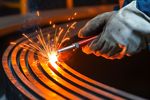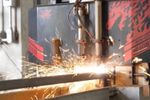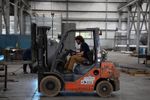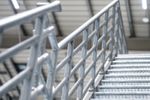Many industries use steel components and complex assemblies for indoor and outdoor spaces that can be impacted by the environment. This metal can experience excessive corrosion when atmospherically exposed. Steel can also experience corrosion when buried underneath the ground, immersed in salt water, or embedded inside concrete.
To minimize this corrosion, hot-dip galvanized steel can be used during the steel fabrication process to ensure a quality coating that withstands the test of time.
What is Hot-Dip Galvanized Steel?
Hot-dip galvanized steel (also referred to as batch or after-fabrication galvanizing) is a coating process to line metal in corrosion-resistant zinc.
After steel fabrication, the metal is cleaned to remove grease, oils, and mill scale lying on the surface. Then, the metal is dipped into a kettle filled with molten pure zinc and additives. The zinc bath reacts to the steel at a metallurgic level and forms a corrosion-protective coating.
The galvanizing process ensures that every area of the steel, even edges and crevices, becomes coated. Hot-dip galvanizing steel is commonly found throughout a range of industries, including construction. This metal is also used in the energy sector by electrical utilities for power transmission towers and other applications. On a smaller scale, metal sculptors may also use hot-dip galvanized product when creating projects that will be placed outside.
Key Considerations When Working with Hot-Dip Galvanized Steel
When working with hot-dip galvanized steel, the American Galvanizers Association recommends design and fabrication considerations that every fabricator should be aware of in the fabrication process.
Ignore these key considerations and you may be dealing with a host of issues, including strain-age embrittlement, working parts that experience undue friction, a zinc coating that could be damaged during welding, or welds that may not hold.
**Design Considerations
**
When designing with hot-dip galvanized steel, keep in mind that the steel may have different thicknesses, which can impact the functionality of sub-assemblies and components. There may also be parts with overlapping surfaces that could cause the coating to wear more quickly.
During the design phase, also consider the types of steel that are selected for the component or finished goods. Every steel type will have different metallurgical properties when interacting with the molten zinc, which can lead to strain-age embrittlement and cracking of the material. Lastly, galvanized steel requires proper venting and drainage to allow the cleaning solutions and molten zinc to pass through for a consistent and even coating.
Fabrication Considerations
When fabricating with hot-dip galvanized steel, you have to take into account how you will join the steel together with other similar and dissimilar materials. A big consideration is when you plan to use fasteners on the metal. The fasteners should be of a compatible material to the zinc coating and have the same or greater corrosion resistance so it doesn’t lead to premature failure in other materials.
If you will be welding metal parts together using spot welding or metal-arc welding, ensure that precautions are made to prevent the zinc from penetrating the weld spot that can lead to cracking. Also, always make sure there is compliant ventilation or air filtration around the fabrication operations, as very high temperatures on thick zinc coatings can release toxic fumes that can impact worker health.
If using electric resistance welding, you’ll also need to pay close attention to your welding parameters and ensure the electrodes don’t become too hot, which can cause a number of issues with the zinc coating.
Southern Metal Fabricator’s Hot-Dip Galvanizing Capabilities
Understanding the properties of hot-dip galvanized steel and how to engage in steel fabrication to create superior end products and sub-assemblies is vital to safe and productive operations.
Which is why many of our customers turn to us for our full-service fabrication capabilities that include an in-house finishing shop where we offer hot-dip galvanizing, surface preparation, painting, and more.
We have extensive experience in hot-dip galvanizing steel after a structure or sub-assembly has been put together. Additionally, we can also order and fabricate galvanized materials into products — something we have done for customers when fabricating industrial ladders and stairs for bulk storage solutions.
Whether it’s consulting with you on material considerations or recommending design and engineering best practices to achieve the highest quality hot-dip galvanized coating, our goal is to exceed your requirements with respect to quality, budget, and delivery.
If you’re ready to discuss the specifics of your hot-dip galvanized steel fabrication project, give us a chance to say, “Yes, we can do that!” by contacting us today.





